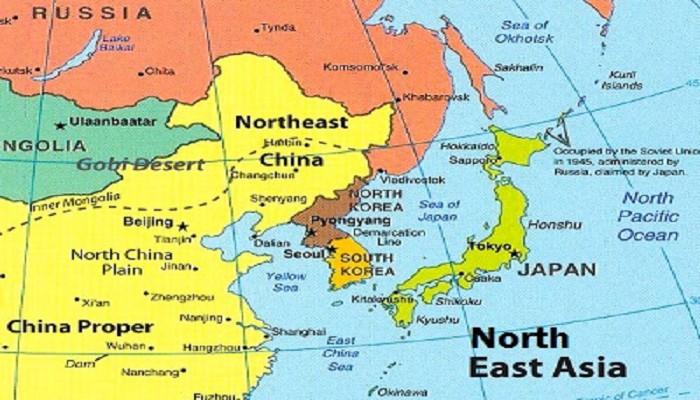Geopolitical Churning in North East Asia
- In Foreign Policy
- 01:29 PM, Mar 29, 2017
- Ramaharitha Pusarla
North Korea has now successfully tested its rocket engine and inching closer to development of Intercontinental Ballistic Missiles (ICMB). North Korea’s missile testing spree is speeding up and portending immense danger for the security of the region. Over 20 years of international sanctions have failed to bring DPRK onto the path of denuclearization. DPRK’s burgeoning assertiveness and relentless nuclear buildup is now cause of intense consternation. The heat of situation is more critically felt by South Korea. The twin-Korean Republic capitals are 120 miles away and this alarming nuclear arsenal development prompts deployment of THAAD (Terminal High Altitude Area Defense System) in South Korea to intercept any incoming missile. The installation of THAAD is critically objected by China.
North Korea had been now the front runner of international headlines for its unprecedented number of missiles launches and nuclear tests since last year. While nations are struggling to conclusively figure out a solution to tame DPRK, the infamous assassination of Kim Jong Nam, half-brother of Kim Jong Un in Malaysia on Feb 13th with a proscribed nerve agent VX further stoked new fears. This event has taken away international attention from the launch of a solid-fueled Pukguksong-2 (North Star-2) capable of hitting the US bases in Okinawa and Guam on Feb 12th. This attempt was a front runner to Scud missiles launched on Mar 7th. Use of VX nerve agent had indeed startled the international community forcing it scrutinize UN report that warned of the unabated nuclear proliferation activity of DPRK. According to the Nuclear Threat Initiative, DPRK has the third largest stockpile of chemical weapons (1). DPRK is one of six countries which refused to sign the Chemical Weapons Convention of the UN passed in 2006 following its underground nuclear test. While it signed the Geneva Protocol that prohibits used of chemical weapons, it doesn’t prevent the country from producing and accumulating the stockpile. It is believed to have 2500 to 5000 tons of CW agents and capable of producing nerve agents like Sarin and VX. Reports suggest that China and Malaysia exported the chemicals to manufacture CW. For long nations simply ignored the threat since DPRK was reeling under threat and hence their ability to produce CW might have been hampered. But the use of nerve agent VX for assassination has ignited fresh suspicions. DPRK had supplied CW to Syria. In 2009, Greece has intercepted North Korean vessels carrying CW heading towards Syria. North Korea has technology to deploy CW with field artillery, FROG rockets, Scud and Nodong Missiles and now it is developing aiming at ballistic missile delivery.
DPRK irked by the joint military operation of South Korea and US and THAAD installation on March 7th as a show of strength launched four Scud-missiles that landed in the exclusive economic zone of Japan. Post-launch, DPRK announced that “situation is already on the brink of nuclear war” and confirmed that these missiles were tasked to hit the US bases in Japan. The launches came at a time when Trump in a twitter post indicated that ICBM testing will not happen. Indeed, North East Asian region had never been so dangerously posited as now.
The assassination besides ruining the diplomatic relations between North Korea and Malaysia had earned the rebuke of China. China with an immediate effect, in accordance to UNSC Resolution of 2321 imposed sanctions on importing coal for the rest of the year. Till now China refrained from imposing sanctions on DPRK despite international pressure and terminated purchases after assassination as it offered protection to Kim Jong Nam in Macau. It is widely known that besides, Pakistan, China had the most reliable ally in DPRK and stalling of imports drew lot of attention. The depth of China’s engagement with DPRK is very illustrious and Beijing incessantly uses it leverage with DPRK against US. Calling off imports from DPRK has dimensions to it. An economic report illustrated that China stalled imports from DPRK, since the previous year it had imported record high supplies of coal and facing glut. Also, China, ROK and US tamed Kim Jong Nam, a plausible claimant to DRPK throne to obtain insider report of Pyongyang. Hence his unexpected assassination had dented the objectives of these three countries.
Now, it would be pertinent to analyze DPRK’s close ties with China that strengthened after the Korean war of 1948. With ideology driving the bilateral ties, Kim II Song, the founding father of DPRK and later his son Kim Jong II always held China in very high regard. DPRK with its rich reserves of iron ore, coal, magnesite, bauxite, copper, zinc, and other minerals became dearer to China. Until the death of Kim Jong II in 2011, bilateral ties flourished and prospered. Kim Jong Un, who clinched the reins soon turned dictatorial, aspired to break the glitch of being the client state of China. Unlike his predecessors who embarked on state visits to China regularly, Kim Jong Un refused to visit to Beijing. He pursued a “de-Sinification” program and executed Jang Song Thaek, for his close links with Beijing. He was at a higher position in hierarchy and mentor of Kim Jong Nam in 2013. He was accused of abusing power and underselling resources to China. Killing of Kim Jong Nam exemplifies, Un’s efforts to consolidate his unequivocal authority on the regime and to exterminate all challengers to his power.
China is embittered with DPRK, but is left with no options. Beijing aspires to keep DPRK under its strangle hold vanquishing all chances of reunification of North and South Korea. China views a resurgent Korea in alliance with US as a threat to its inimitable rise. Geostrategist Brahma Chellaney, opined that “for centuries, China has seen the Korean peninsula as its strategic Achilles Heel-a region that offers foreign powers an attractive invasion route or a beachhead for attacking China”. China has an unresolved border dispute with DPRK and believes that a unified Korea might rally against China harder. Territorial dispute is about certain islands in Yalu and Tumen rivers and centered on Chongji, where a 33-km stretch of the boundary is unsettled (2). To fortify its territorial claims on North Korea, it is making dubious claims and attempting to rewrite history stating that ancient Kingdom of Koguryo founded on Tongge river basin of North Korean is Chinese, not Korean. Kim Jong Un miffed by Chinese high-handedness is wriggling hard to come out its fold. It is seeking talks with Washington. But the eight-yearlong regime of President Obama grossly misread the situation and intensified sanctions. Sanctions crippled DPRK’s development and shunning of diplomatic engagement propelled Pyongyang’s single-minded pursuit of advancing missile systems and nuclear weapons development process. Now the hastened THAAD deployment in South Korea to protect it against medium and intermediate range ballistic missiles had further deteriorated the vulnerable stability of the region. While the indispensability of THAAD is still an issue of larger debate as it is untested, talks of its installation is brewing trouble in the region.
THAAD deployment by the US in South Korea to protect its ally was viewed with suspicion. As the X-band radar of THAAD with a range of over 2000km can keep a watch on China and detect its missiles in flight. So, China is vainly persuading the US from deploying THAAD. On the other hand, China’s relations with ROK have touched a new low. China is instigating protests, stirring up anti-American sentiments in ROK and stepped up retaliatory tactics. China ordered the tour agencies to cut trips to South Korean island Jeju, popular among Chinese travelers. Imports of cosmetics, electronic goods are blocked. Telecast of Korean entertainment programs is stalled. China is largest trade partner of ROK and economic stand-offs might have a toll on the Asia’s fourth largest economy. ROK is currently battling domestic insurgency with Constitutional Court upholding the impeachment of President Park Guen-Hye and ordering election within the next 60 days. China is already exploiting internal turmoil of ROK. China is bolstering the moves of Minjoo party opposing the deployment of THAAD in South Korea. Already the lawmakers and Minjoo party workers are regularly visiting China to workout strategy of renegotiations with US for THAAD installation.
The unabated missile development of DPRK is keeping the US on tenterhooks. US adopted a similar strategy of imposing economic sanctions on Iran and North Korea, both non-signatories of NPT and straddling the path of nuclear proliferation. While US for time being had tamed Iran, its North Korean strategy outsourced to China had backfired. North Korea soon mastered the art of flouting sanctions with evasive techniques. Reports revealed that DPRK began using foreign citizens as facilitators and relied on front companies to operate with key countries like China, Malaysia, and Singapore (3). Kim Jong Nam’s assassination clearly validates the claims of the report, wherein foreign nationals are employed to carry out the task. Till now, Malaysia for its favorite country for carrying all its operations, which allowed North Koreans to travel visa-free until the assassination. Incidentally, with Chinese covert support, DPRK is pulling on well despite sanctions without much trouble. Though China has announced blocks on imports, they not exhaustive and fool proof. DPRK is crucial for China’s vital geostrategic interests and Beijing will desist from playing hard ball with Pyongyang. Collapse of DPRK might indeed be deleterious to Chinese interests. It is time, US and other countries come up with viable solutions and persuasive diplomatic engagement to bridle unrestrained galloping of DPRK along path of nuclear proliferation. Trump administration should review its North Korean policy now.
China is in war of words with Japan also with Tokyo all set to send its largest warship, Izumo on a three-month tour to Indonesia, Singapore, Philippines, and Sri Lanka through the South China Sea before joining Malabar joint naval exercises with Indian and US vessels. China’s unapologetic aggressive assertions and United States inadept Asian policy has eventually turned North East Asia into potential rivalry zone.
- http://www.nti.org/learn/countries/north-korea/chemical/
- http://www.japantimes.co.jp/opinion/2017/03/06/commentary/world-commentary/rising-power-without-allies/?utm_content=buffer66822&utm_medium=social&utm_source=twitter.com&utm_campaign=buffer#.WM7d64VOLIU
- http://www.livemint.com/Opinion/TpVYxBJ5SwGnb0fZjkaUmI/NorthEast-Asia-goes-dangerously-ballistic.html
Disclaimer: The opinions expressed within this article are the personal opinions of the author. MyIndMakers is not responsible for the accuracy, completeness, suitability, or validity of any information on this article. All information is provided on an as-is basis. The information, facts or opinions appearing in the article do not reflect the views of MyindMakers and it does not assume any responsibility or liability for the same.







Comments